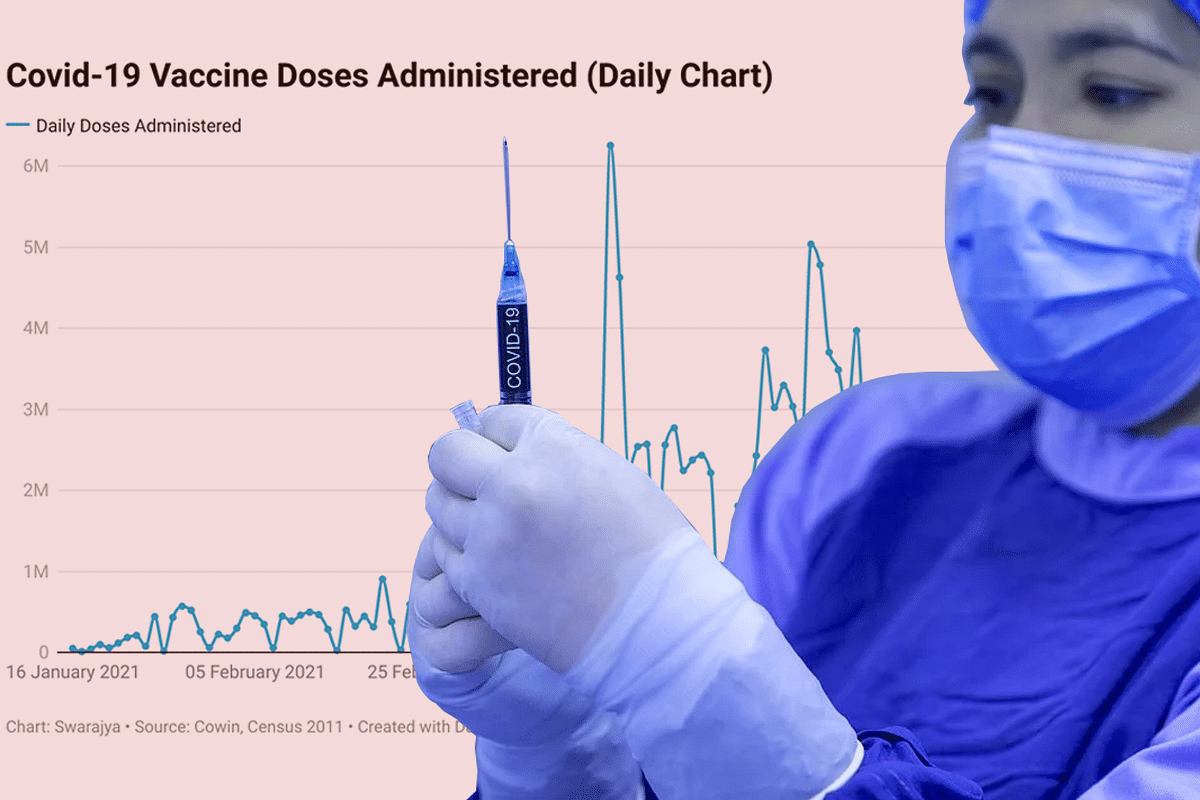News Brief
Explained: Centre’s New Vaccination Strategy To Be Implemented From 21 June
- The centre has recommended states to strictly follow the “very crucial” five-step strategy: COVID-appropriate behaviour, test, track, treat, and vaccine.
- Worldwide, India ranks third in terms of the doses administered, and second in terms of the number of vaccinated people.

Vaccinating India
A few weeks ago, Prime Minister Modi had announced that the union government will supply COVID-19 jabs to the states free of cost to inoculate all above 18 years of age from 21 June, that is, tomorrow. Guidelines have been shared by the Government of India regarding the same.
Under the guidelines, the vaccination has been centralised in the hands of the centre which will procure 75 per cent of the vaccines manufactured in the country. The remaining 25 per cent vaccines will be procured directly by the private hospitals.
The COVID-19 vaccine doses will be given free to the states and union territories by the central government, based on criteria like their population, disease burden and the progress of vaccination drive.
According to the guidelines:
- After 21 June, everyone is entitled to free COVID-19 vaccination from the government irrespective of their income status, but the government encourages those who have the ability to pay to use private hospital's vaccination centres.
- The government will also provide non-transferable Electronic Vouchers to economically weaker sections which can be redeemed at private vaccination centers.
- The government has put a cap of Rs 150 on the amount private hospitals can charge over the cost price of the vaccine. The state governments are responsible to enforce this.
- The CoWIN platform already provides every citizen the facility of pre-booking vaccination appointments online. The state governments are expected to come up with a detailed procedure for onsite registration facility for individuals as well as groups of individuals for both government as well as private vaccination facilities.
- Health care workers (HCWs) and frontline workers (FLWs), those above 45 years of age, citizens whose second dose is due will be given priority.
- Within the population group of citizens more than 18 years of age, state governments will decide their own prioritization factoring in the vaccine supply schedule.
- The central government will provide the states advance information of vaccine doses to be supplied to them, and in return, the states should also allocate doses well in advance to districts and vaccination centers.
- States are also expected to put in the public domain the information about the availability of vaccines at district and vaccination center level, and widely disseminate it among the local population, maximizing the visibility and convenience of citizens
- The states will also aggregate the demand of vaccines of the private hospitals keeping in view equitable distribution between large and small private hospitals and regional balance. Based on this, Government of India will facilitate the supply in lieu of payment through the National Health Authority's electronic platform.
- If state governments waste vaccines, it will affect their allocation negatively.
The Prime Minister had also clarified that the guidelines will also be reviewed from time to time as the vaccination progresses.
The state governments across the country are releasing revised vaccination strategies in response to these guidelines.
Himachal Pradesh has divided the beneficiaries into two categories and adopted a fixed day approach for vaccination. Category A beneficiaries (those above 45 years of age, those due for a second does, and HCWs and FLWs, and all priority groups notified by the state government) will be vaccinated on Thursday, Friday and Saturday, while Category B beneficiaries (all the remaining) will be vaccinated on Monday, Tuesday and Wednesday.
Uttar Pradesh has also begun the pilot testing of its new vaccination strategy in four clusters in each of the 75 districts of the state on Thursday (17 June). Uttar Pradesh is following a cluster approach - each block is divided into smaller units consisting of several villages. Then, a list of eligible beneficiaries is drawn up using the electoral rolls. Health teams are deployed to give voter like slips to each household days before vaccination. The approach aims to ensure no eligible person is missed.
Meanwhile, the union government has warned states to step up the COVID-19 vaccination and open up lockdown in a “carefully calibrated" manner. If COVID-appropriate behaviour is not followed, then the third wave can hit the country in six to eight weeks, it said yesterday (19 June).
The states have been recommended to strictly follow the “very crucial" five-step strategy: COVID-appropriate behaviour; test; track; treat; and vaccine.
Currently, an average of 33 lakh doses of COVID-19 vaccine are being administered per day in India. Close to 27 crore doses of vaccines have been administered till now, covering 23.4 per cent population overall, while over 40 per cent population above age 45, with at least one dose. Around 5 crore people in India have been fully vaccinated.
Worldwide, India (total population 1,380 million) ranks third in terms of the doses administered (around 270 million), and second in terms of the number of people fully vaccinated (50 million).
Introducing ElectionsHQ + 50 Ground Reports Project
The 2024 elections might seem easy to guess, but there are some important questions that shouldn't be missed.
Do freebies still sway voters? Do people prioritise infrastructure when voting? How will Punjab vote?
The answers to these questions provide great insights into where we, as a country, are headed in the years to come.
Swarajya is starting a project with an aim to do 50 solid ground stories and a smart commentary service on WhatsApp, a one-of-a-kind. We'd love your support during this election season.
Click below to contribute.
Latest